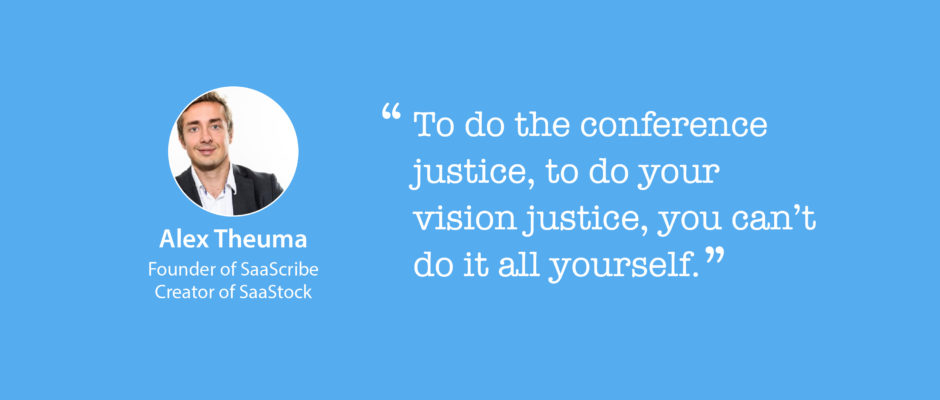SaaStock, the latest and poised-to-be greatest event for Europe’s SaaS community, is coming up on September 22. We’re really looking forward to being there in Dublin, hearing from industry leaders, and meeting people from around the world.
In our anticipation, we transcribed our recent SaaS Open Mic podcast with Alex Theuma, founder of SaaScribe and SaaStock. Having started from scratch and now launching a large-scale event, Theuma has great insight to share about community building and getting involved in SaaS. Enjoy!
https://soundcloud.com/chartmogul/alex-theuma-saascribe
Introducing a SaaSpreneur
Ed: I was going to start by explaining your background and what you do. But I thought it would be cool if you do that instead. So if somebody asks you what you do, what would you tell them?
Alex: It depends who asks me. To any lay person, I guess I could say I’m a “SaaS-preneur.” Actually that might confuse them even more… But I’m the founder of SaaScribe and SaaStock. In its simplest terms, that’s what I am. For those listening, SaaScribe is an online/offline community for SaaS startups, which includes the blog Saascribe.com, the podcast the SaaS Revolution Show, and a Slack channel (SaaS Founders Club). All of those properties live in the online world.
And toward the end of last year we started thinking — if you’re talking community, you have to do more in the offline world. You can’t just be sitting at your desk in your home office, uploading content and tweeting, and building a community that way. You need to get out of the office and try to do more offline.
So we’ve been hosting SaaS meetups. I’m not content with doing those just in the UK, so we’ve done some in the UK, in Dublin, even one in Berlin. We’ve done about 8 so far.
And finally a kind of 10x meetup, which will be SaaStock — the premiere European conference for B2B SaaS founders, execs, and investors, which is taking place on the 22nd of September in Dublin. It’s hopefully going to be very similar to some of the meetups we’ve had, but 10x. It’s going to be about networking, sharing valuable insights, and having a bit of fun as well.
So yeah, that’s the long version of what it is that I do.
[Editor’s note: I attended the SaaScribe meetup in Berlin, and it was great! Check out my recap of the “growth through retention” discussion.]
SaaScribe, the independent SaaS community
Ed: There are a few SaaS-related communities out there. But I think pretty much all of them are in some way tied to a brand that is selling a product, and it’s really a side thing to grow an audience, for marketing purposes or brand recognition.
But SaaScribe struck me as something outside of that. Because you are building this community pretty much from scratch. What’s the reason behind that? Why did you do it?
Alex: I guess I started SaaScribe because… I spent 11 years or so in sales, in tech sales selling IT support, selling cloud computing which merged into saas. SaaS was the only thing out of those different services and products that I found exciting, sexy, and cool. It connected with me a lot more than the others. Then I found out that the people working in SaaS were also exciting, sexy, and cool, right?
The truly great thing I found within this SaaS space is that people were willing to share, to help others learn. It was something I’d never experienced before and something I wanted to be a part of.
So what I decided to do is to go a little out of my comfort zone, to start writing some content — stuff I knew that, in comparison to some of the thought leaders out there (like Lincoln Murphy), was very inconsequential. But it was something I wanted to do. The idea of SaaScribe resonated with part of the SaaS startup community, more so than the initial content of the early days, which was a bit ropey at best.
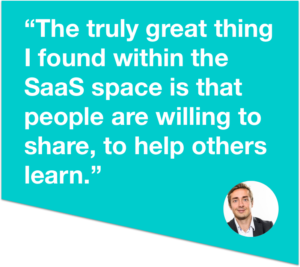 It took off from there. One day I was thinking actually I’m quite passionate about SaaS. I’m reading the thought leaders, and a lot of the stuff is marketing for a product or a company. There wasn’t anything or anybody doing it independently and unbiased. Without portfolio companies of VCs.
It took off from there. One day I was thinking actually I’m quite passionate about SaaS. I’m reading the thought leaders, and a lot of the stuff is marketing for a product or a company. There wasn’t anything or anybody doing it independently and unbiased. Without portfolio companies of VCs.
So to come with a neutral, non-biased perspective, not trying to market or sell anything in the early days, that was our idea. And the idea took hold and the first couple of months we saw some rocketship growth in terms of traffic. And ever since then we’ve just been continuing with it.
Ed: Do you think you have a benefit in not being tied to a marketing projecting or a brand? Do you think that’s what allowed you to see this growth so early on?
Alex: Yes, I think so. But I think there are pros and cons to both.
I think so because we were (and still are) independent. Somehow that struck a chord with the community. Also the initial volume of content that we put out was probably a bit too much. But it meant that people knew about us by default because we were putting out 4-5 pieces of content per week. And they were surprised it was only two of us behind it at the time. People within the SaaS community are curious and hungry to learn, so their curious nature took them to SaaScribe, to sign up for yet another newsletter. We’ve kept many of those on board.
There are drawbacks. I wouldn’t say we’re necessarily competing with the likes of HubSpot’s blog or Close.io. But these are companies that have a lot of money and can invest a lot into the production of content and podcasts and also promotion, to go beyond what we can as a bootstrapped self-funded startup. So it can be difficult if we were looking for specific metrics or numbers, like 1000 post reads. It’s not easy to obtain that every time.
Delivering real value as a SaaS community
Ed: So it’s 2016. A lot of people in this space pushing out content. And a lot of it, if I’m honest, is mediocre quality. There’s a lot of noise.
Let’s say I’m trying to start a community in a vertical today. What kind of approach would you suggest? How did you do it with SaaScribe? Did you just start writing, or was there more of a method to it?
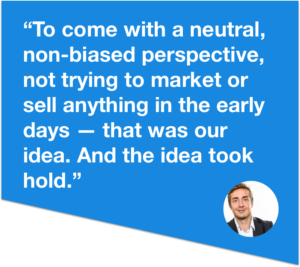 Alex: I don’t think there was really a method to it in the beginning. It was just: starting to write. We got set up on WordPress and started putting out our first few posts. And probably, to be honest, we were still trying to find direction. “Are we still truly a community or are we gonna go down the route of doing news?” So in the early days we weren’t really 100% on what was happening with it.
Alex: I don’t think there was really a method to it in the beginning. It was just: starting to write. We got set up on WordPress and started putting out our first few posts. And probably, to be honest, we were still trying to find direction. “Are we still truly a community or are we gonna go down the route of doing news?” So in the early days we weren’t really 100% on what was happening with it.
But then, I can’t remember why, but I decided I’d start doing the podcast. The first guest was Mark Roberge. That continued and we just saw the first anniversary of the podcast, have probably done about 40 or so of those since then.
And I think the other thing was that it just started to grow. There wasn’t this grand master plan like, “Okay, to build a community, this is what we’re going to need to do. We need all these offline channels and these online channels.” It just all fell into place and was pretty logical. There was no one doing SaaS meetups in Europe or the UK, so wouldn’t it make sense that what I’m doing with SaaScribe, I take the initiative and do meetups? And that’s what happened.
If someone were going to do it today, and they knew they wanted to set up a community, I guess those communities can take different forms. There’s the Reddits and the Growthhackers — you can find software out there that will give you that kind of online community. Or do you want to do content and drive engagement through that? Therefore having some kind of blog might be your option.
But Slack communities are really interesting as well. And I’ve seen a lot of people in the last year going in that direction. Some succeeding and some failing, because I think it’s quite difficult to — I don’t want to say moderate — but the level of communication, when you only have one channel, you can kind of feel like you’re drowning at times. But still, very interesting.
Ed: Yeah, I think I’m logged into about nine Slack communities now. And it’s kind of proven to me the breaking points where Slack no longer scales well for the user. I think there’s something really interesting there, and I have had some occasions where it’s great to casually chat with people. But I’m at the point where my Slack doesn’t ever have an unread notification on it. That’s the problem.
Alex: Yeah. I joined one or two before I started my own. And the problem I found with those was that you have about 40 people in the community, and there would be two channels: a “general” channel and a “please share” channel, for sharing content. So if I hadn’t logged in for a day or two, there would be 50 or so unread notificat ions. And I was never going to read all of those. And when you’re on it, the constant notifications can become a bit of a distraction or annoyance.
ions. And I was never going to read all of those. And when you’re on it, the constant notifications can become a bit of a distraction or annoyance.
So when I set up SaaS Founders Club, which is strictly for SaaS founders only, I knew these are very busy people who perhaps want fewer distractions. But also I had to engineer it so they can get value out of it. We’ve got loads of different channels. Actually in the main channels, there isn’t a lot of activity. A lot of the activity is done in direct messaging. So the value is being served from this community, but it’s being done in a manner that doesn’t disturb everyone publicly. So that seems to be working well and that’s growing.
I think if you get it right with Slack, it’s a good forum for a community.
From community to conference: launching SaaStock
Ed: You mentioned that you’ve slowly moved into events in the last few months. Actually I’ve been to a couple of the SaaS meetups — it’s a great sense of community and you’ve got great people talking there.
But now you’re working on this much bigger thing, SaaStock.
What are some of the challenges around deciding to host a big conference? And going from nothing to actually hosting it? I know it hasn’t happened yet, but I’m sure you’ve come across some things along the way that you hadn’t expected.
Alex: Yeah! It’s really hard work. I think when I initially decided that I was going to do SaaStock, I kind of thought for a moment that I would be doing this all myself. That was a very short moment.
I’m pretty much on the conference full-time at the moment, as well as managing SaaScribe. I’ve got a guy that’s working with me. Chris, who’s helping me, he’s working on the demand generation and owning the ticket sales side of things. But we’re pretty much wearing many hats right now. We’re looking at bringing in a third full-timer already, because of the sheer workload we’ve given ourselves from the ambitions we have for SaaStock.
Behind that we have a production company called Catapult Events. These are the guys that worked on Web Summit, and they even managed the production for the InsideIntercom World Tour. They manage the creative, the event management, etc. So what we need to do is focus on the sales and marketing side of things, and a few logistics.
But there’s just so much work to do. The sheer amount of work for a conference of this size has been the main challenge. We’re capable of doing everything, even though we’re very new to the conference business. But it’s just the workload — there aren’t enough hours in the day, hence why I’m hiring. I think eventually we’ll need to grow out a decent-sized team.
To do the conference justice, to do your vision justice, you can’t do it all yourself.
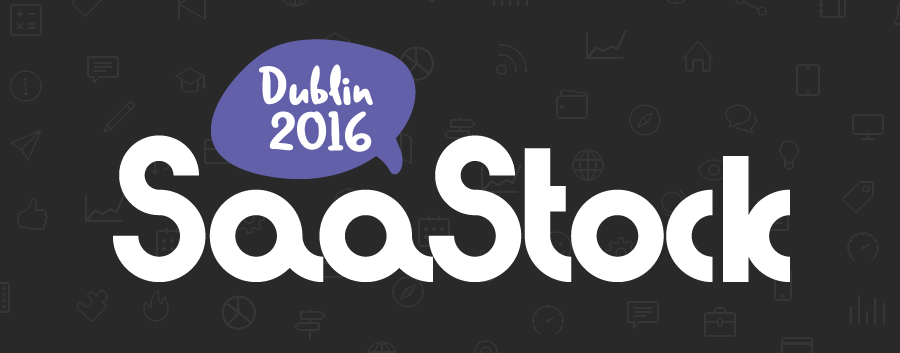
Ed: It seems like you’re going for a pretty big event. I think if you look at conferences, particularly tech ones, along the timeline since their conception, most of them slowly grow. Is there anything that you can cutdown in the first iteration that makes things easier? Or do you have to go all out, straightaway?
Alex: Well, we are kind of going all out in a way, but I think we are still being sensible.
If you have a look at these tech conferences, when they start out, a lot of them start out on this magic number of 300 — 300 attendees for the first year. And then double or triple in size, from 300 to maybe 2000 in just year 2. Web Summit is an outlier wherein they started with 300 and in four or five years, they’re at 42,000. They’ve scaled incredibly.
We did our market research in regard to SaaS companies and startups in Europe. But also the content is going to be relevant to a global SaaS audience. We’re hoping there will be a global SaaS community there. We’ve got folks coming in from North America and New Zealand.
If I had gone with the number 300, just to be conservative, just because everybody else has been doing that, then I would have been disappointed talking to you today. Because we’re almost coming up on that mark in terms of tickets sold, and we’re still four months away. So I think we’ve given ourselves a good target. We’re working hard at that, and it’s very achievable.
In terms of pure independent SaaS conferences, for a SaaS community, there aren’t that many. I guess the obvious one is SaaStr — and they had 5,000 in 2016, looking at 10,000 next year. The SaaS founders are hungry to go to these types of events and do business. I think your CEO, Nick, went to the first SaaStr and met some very important customers of ChartMogul today. So attending these conferences is very valuable for SaaS founders that sell to other SaaS companies, especially in the early days.
We’ve got to deliver huge value to our delegates beyond the content, just through everything. Make sure everyone has a fantastic time so that everyone comes back next year.
Building relationships, and a business, through conversation
Ed: So I guess you’re still a salesperson at heart. How is it selling conference tickets or speaking spots? Is that something that’s difficult in the beginning when you don’t have an established event already? Are there any tips you have for people trying to recruit speakers or sell conference tickets?
 Alex: Yeah, definitely my sales background has helped. I know of a lot of people who are in the conference game and don’t have that sales background, and therefore haven’t done so well on the sponsorship side, for instance. That’s simply because they don’t have that natural inclination to send cold emails or pick up the phone, whereas I’m really used to that. I’ve been doing it for 11-12 years.
Alex: Yeah, definitely my sales background has helped. I know of a lot of people who are in the conference game and don’t have that sales background, and therefore haven’t done so well on the sponsorship side, for instance. That’s simply because they don’t have that natural inclination to send cold emails or pick up the phone, whereas I’m really used to that. I’ve been doing it for 11-12 years.
Also, if I didn’t have the one year under my belt of SaaScribe, it would have been a totally different speaker lineup. It would have been really challenging. Even six months ago, through SaaScribe, I was strategically building local relationships, with people at Intercom, people like Christoph Janz etc. So when I told them about the vision of SaaStock, it was easier to secure those first speakers. I actually think the first speakers we got on board were Des Traynor, Christoph Janz, and Nikos of Workable.
So the tip is: if you can land your first couple of speakers, and if they are good names, and if you’ve done that through building relationships — strategically, long term before your conference — then once you send an email to someone else, and you tell them who you have on board already, it makes it much easier.
I think SaaScribe played a massive part in what SaaStock is today. It just gave me that little bit of credibility. People knew who I was when they received my email. That helped the curation part of what now is a really awesome, strong line-up.
Ed: Yeah, that’s an interesting point actually and something I’ve noticed having done some podcasts at ChartMogul. Using that as a tool for either relationship building or even customer success is really interesting. We do a lot of content with out customers — we tell stories about how they grow their business and everything else related to the SaaS universe. And it’s almost as valuable for our customer relationship as it is for the listeners.
I know you could argue that that’s a big investment, to go around and do a podcast with each of your customers to make them happy, but I think it’s a good point. And it’s something I’ve seen over the last few years. People value it and it turns into longer term relationships that you can leverage in the future.
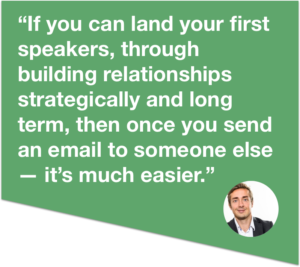 Alex: Yeah, absolutely. And even not just for your existing customer relationships, or having a podcast for ChartMogul’s customers… I’ve seen a lot where founders of SaaS companies are starting up their own podcasts and interviewing or recruiting guests, kind of as a sales tactic.
Alex: Yeah, absolutely. And even not just for your existing customer relationships, or having a podcast for ChartMogul’s customers… I’ve seen a lot where founders of SaaS companies are starting up their own podcasts and interviewing or recruiting guests, kind of as a sales tactic.
They want to connect to this guest, the guest is flattered to be on the podcast, and at some point — I don’t know when — there’s probably going to be a conversation like, “Hey, what about our product? Would you like to try it out?”
This is a great way to open doors. And it’s relationship building. That’s what it’s done for me from the SaaStock perspective. For SaaS founders, it might be interesting to try the podcast channel.
Final words
Ed: You’ve got a ton of great interviews on the site now, whether it be a podcast or a written piece. I guess you’ve learned quite a bit across those interviews. I’m wondering if you have a favorite and if there’s something you’ve learned from it that you didn’t know before.
Alex: Yeah, I mean it’s a bit like asking which one of your kids is your favorite. Do I have to say I love each and every one of my podcasts the same?
Well, I love the first one. We had Mark Roberge, Chief Revenue Officer of Hubspot. That was a really good coup, to get Mark to do a podcast’s first episode when there was no credibility about it. But clearly I wrote a good email that resonated with Mark and he was a great guy, and he agreed to do it. (Of course he had a book to promote at the time, so that helped.)
That was really enjoyable. He gave incredible tips on building a sales acceleration machine. There are probably too many tips to mention so I suggest you listen to that particular episode of the SaaS Revolution show.
Throughout all of them, I’m learning a ton. And I would say this has really ramped up my acceleration of knowledge on SaaS, hosting these podcasts. So I’m learning and hopefully my audience is learning at the same time.
Ed: Okay I’ll let you get on. Before we go, is there anything you would like people to check out? Where can people find you?
Alex: SaaScribe.com. If anyone hasn’t heard of it before, check it out. We think it’s a great, neutral resource for SaaS startup founders.
Of course I have to get a cheeky plug in for SaaStock as well. If you’re a B2B SaaS founder, investor, or exec, then SaaStock will be the conference in 2016 where you can learn how to build a category leading business and turn your SaaS to 11. We’ll hopefully see you there!

